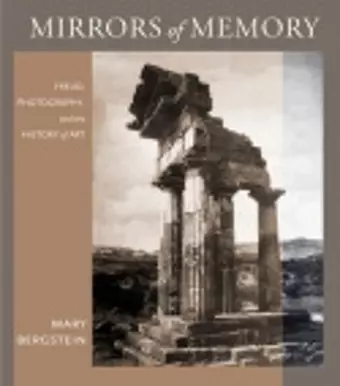Mirrors of Memory
Freud, Photography, and the History of Art
Format:Hardback
Publisher:Cornell University Press
Published:15th May '10
Currently unavailable, and unfortunately no date known when it will be back

Photographs shaped the view of the world in turn-of-the-century Central Europe, bringing images of everything from natural and cultural history to masterpieces of Greek sculpture into homes and offices. Sigmund Freud's library—no exception to this trend—was filled with individual photographs and images in books. According to Mary Bergstein, these photographs also profoundly shaped Freud's thinking in ways that were no less important because they may have been involuntary and unconscious.In Mirrors of Memory, lavishly illustrated with reproductions of the photos from Freud's voluminous collection, she argues that studying the man and his photographs uncovers a key to the origins of psychoanalysis. In Freud's era, photographs were viewed as transparent windows revealing objective truth but at the same time were highly subjective, resembling a kind of dream-memory. Thus, a photo of a ruined temple both depicted the particular place and conveyed a sense of loss, oblivion, of time passing and past, and provided entry into the language of the psychoanalytic project.Bergstein seeks to understand how various kinds of photographs—of sculptures; archaeological sites in Greece, Rome, and Egypt; medical conditions; ethnographic scenes—fed into Freud's thinking as he elaborated the concepts of psychoanalysis. The result is a book that makes a significant contribution to our understanding of early twentieth century visual culture even as it shows that photography shaped the ways in which the great archaeologist of the human mind saw and thought about the world.
An erudite and original book... [on] the far-reaching effects of European fin de siècle visual culture on Freud's mind. Mirrors of Memory illuminates the heretofore unexamined ways in which the medium of photography, widely taken to be a transparent, objective way of documenting and gaining access to a previously existing reality, was relied on by many disciplines during Freud's lifetime.... This extraordinary book... is a paragon in the annals of interdisciplinary scholarship.... In teaching us to look back and to realize that we had missed an entire field of force in which the interpretations we thought we understood took place, it opens onto new vistas and suggests new paradigms for exciting twenty-first-century interdisciplinary work.
-- Ellen Handler Spitz * Journal of the American Psychoanalytic Association *Bergstein's book significantly furthers our understanding of Freud’s Vienna and her rich data and analysis open many avenues for further research, particularly on the question of how the modern innovation of photography affected the development of art history and psychoanalysis in the late nineteenth century.... Bergstein provides a rich archive of information and analyses that future scholars will no doubt find indispensable.
-- Maya Balakirsky Katz * Visual Resources *Bringing analytic understanding to bear on cultural production, Bergstein explores the impact of photography on the human dynamics of perception, memory, and desire. At the same time, Mirrors of Memory historicizes psychoanalysis, shedding light on the circumstances that positioned Freud to formulate a new understanding of mental life.... Bergstein highlights the rigor with which Freud approached his investigations of mental life. She also enriches our understanding with her careful demonstration of the ways in which 'photographic presence and surrogacy were deeply embedded in Freud's visual imagination.’.
-- Anne Golomb Hoffmann * DeWitt Wallace Institute for the History of Psychiatry Annu- Winner of Winner, 2012 Courage to Dream Book Prize, given by.
ISBN: 9780801448195
Dimensions: 203mm x 178mm x 27mm
Weight: 907g
344 pages